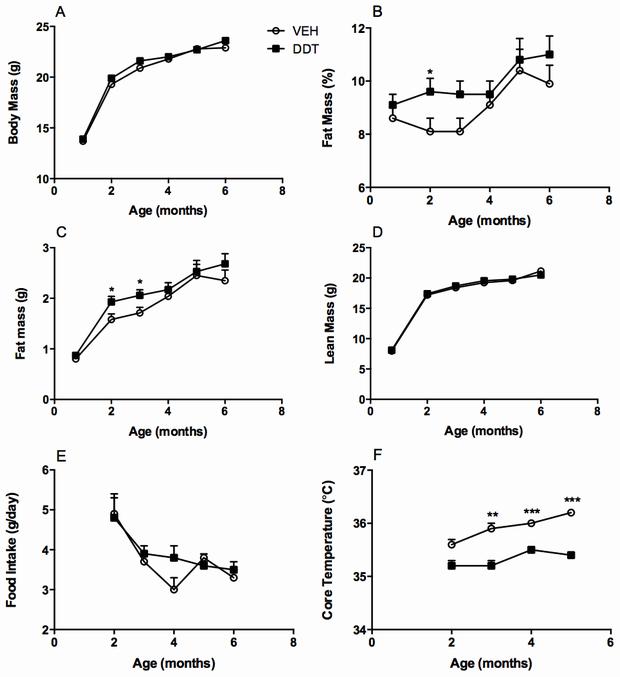DDT, the first modern pesticide, has been banned in the United States since 1972 but it is still commonly used in places where malaria is prevalent. The United Nations recommends it because it is far less harmful to people than malaria is and remains superior to replacements. Malaria drugs have become less effective over time so it's better kill pests before they infect people.
In America, DDT has only been proved harmful to animals in the laboratories that are trying to prove DDT is harmful, but concern over improper use decades ago led to worry of a suspected relationship between exposure and reproductive effects in animals and the newly-formed EPA used the precautionary principle to unregister it. A new epidemiology paper in PLOS One doesn't try to prove that, the authors instead correlate DDT use from generations ago with increased waistlines of today. DDT exposure may have made you fat, they conclude.
It was a small study using mice and designed to find increased likelihood of obesity and type 2 diabetes. The researchers used olive oil mixed with technical grade DDT at 1.7 ppm - below safe standards set by the EPA and realistic for countries where malaria is common. It's a reasonable experiment and the authors avoid the weaknesses of many past studies, where outrageously high levels using gavage dosing and surfactants were common. Bonus: Unlike other studies of other pesticides that made provocative claims, the authors included their data, so critics can complain about the methodology if they want but they can't complain about the transparency.
The researchers found an intriguing effect; pregnant female mice fed DDT and their female offspring had a lower tolerance for cold temperature and other changes in metabolism. Just like humans, if mice aren't burning calories, they are storing them and that means they get fat. A puzzle is why this did not happen to male mice. Aside from a blip in glucose, DDT did nothing to males.

Effect of perinatal DDT on body composition and energy balance in female mice. doi:10.1371/journal.pone.0103337
There are calls to make sure both genders are used in laboratory studies and this is why. Is there something in female mice that makes them more susceptible to obesity and DDT is a catalyst? Or pregnant mice? Hard to say but if only male mice had been used, there would be no paper at all.
Most importantly, is this applicable to humans, as they say it is? Not based on the study. As is well known, the reason so many drugs fail in clinical trials is because lots of effects are modeled in mice that then don't happen in humans. In humans, the dozens of workers who were exposed to high levels of DDT (600X average 1960s levels for up to <20 years) never got cancer but lots of people, both men and women, in their 50s and older are fatter and have developed metabolic syndrome so no one can prove DDT didn't cause that, but it isn't scientific reasoning to insist on disproving a negative. It also has to be noted that metabolic syndrome has become this decade's version of 'endocrine disruptor' - just invoke it and guilt is pre-determined by association. Metabolic syndrome is a cluster of subjectively defined targets for obesity, high blood pressure, high blood sugar, diabetes, high triglycerides and reduced HDL cholesterol. That covers a lot of ground. Almost 50% of older Americans qualify and it would be a spurious correlation to match higher obesity in older people with DDT without more evidence than matching curves.
The authors not only suggest the results apply to humans anyway, they say it is likely. That is a puzzle. Their conclusion - " it is likely that perinatal DDT exposure represents a risk factor for reduced energy expenditure in adult humans, even decades after DDT usage had ceased" - is not only not based on their study they know all those qualifiers - 'likeky', 'a risk factor' - are still going to be interpreted by environmentalists as 'DDT makes women fat decades later' even though their data don't show that at all. The downside to open access is often a lack of real peer review. I criticized one of the most famous journals in the world in the Wall Street Journal two weeks ago and endorsed the company that happened to print this paper, but these sensationalized conclusions slip through open access a lot more. That conclusion would never have passed critical peer review, I have gotten more stringent fact checking from every newspaper I have written for, including when I criticized peer review.
Wondering about that disconnect, I looked at the author bios and did a quick search on the person U.C. Davis put in their press release, lead author Michele La Merrill, assistant professor in the Department of Environmental Toxicology. Professor La Merrill was formerly a contributor to the anti-pesticide site Environmental Health News, so perhaps there is a little bit of personal bias injected by the authors into the concluding remarks. A bold conclusion, that DDT exposure 50 years ago gave women diabetes but not men today, requires bold evidence. This study is a fine starting point, it merits a larger follow-up, but their gigantic leap from a strange result in mice to cause and effect in humans simply shouldn't be there.




Comments